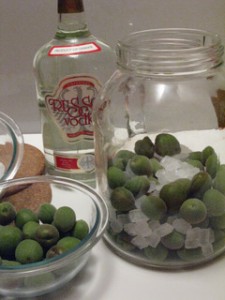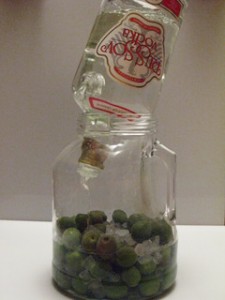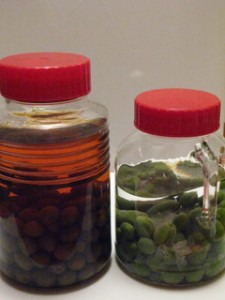My lucky friends have been enjoying my wonderful five-year old, home-made, rich golden-color, mildly sweet and tart umeshu (plum wine) until the supply began to decrease to the point that I was not longer offering it; hording the remaining “wine” for Buzz and me. Umeshu preparation, patience and drinking is a continuous cycle of work and enjoyment. Umeshu is not a fermented product like grape wine, but is simply and extraction of the flavors and juices of the ume by alcohol sweetened with sugar. It takes a year to complete the process, and the longer the time the more delicious the “wine”. While I lived in Japan I never missed the yearly cycle, because when the time came every early summer the supermarkets carried baskets of freshly harvested bright green ume plums along with large glass jars, bags of rock sugar and cartons of distilled white liquor containing about 35 percent alcohol. These materials are always conveniently lined up next to each other at the store.
After moving to New York City the story was different. There are no ume trees on the East Coast. Ume plums grown and harvested in California are sold only at Mitsuwa Marketplace, one of the largest Japanese supermarkets in New York area, in Edgewater New Jersey across the Hudson from New York. And they are only available for one or two weeks sometime during May. Since I do not go to the Mitsuwa Marketplace for shopping every week, in the past 5 years I kept missing the chance to purchase the plums when they came in the store. 
This year Andrew and Kelly, two of my students reminded me about this narrow window for making umeshu. They e-mailed me with a note: Mitsuwa has ume plums this week. I immediately sent Buzz to fetch them. Buzz purchased 12 pounds of plums along with 6 pounds of rock sugar. For the distilled alcohol we went to the Wine & Liquor Warhouse, a great discount wine store in our neighborhood, to purchase the most economical vodka for a source of alcohol. We found 80 proof (40% alcohol) vodka made in Ukraine for $14 for a 1.75 litter bottle. Not so bad.
Plum wine production is very simple. First carefully rinse the plums several times under the cold tap water. With a tooghpick remove the stem from each fruit. Drain and dry the fruit and transfer them to a glass jar, alternating with rock sugar in 8 layers – plum, sugar, plum, sugaer, plum, sugar, plum and sugar.
Then pour the alcohol over the plums and sugar, and cover the jar tightly with a lid. In the photo you see the newly made batch and the 5 years aged liquor standing next each other. 
Store the jar in a dark, cool place. Once or twice every month for the first three months, shake the jar gently to dissolve the sugar in the liquid. After one year, when you are ready to prepare a new batch of plum wine for the next year, you can filter the previous year’s matured wine and remove the plums. You can enjoy it then or let it age even longer with the plums as I have done for us 5 years old stock. After the filtration you have delicious drunken plums left in the jar. Transfer them to a small, clean jar and store them in the refrigerator. They are absolutely delicious to nibble just as they are (I remember diligently assisting my mother who filtered her yearly home-made umeshu, knowing that I could pop some of the delicious drunken plums into my mouth as a reward), so they disappear very quickly.
